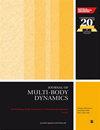Dynamic modelling of deep groove ball bearings with different local defects considering skidding and thermal elastohydrodynamic lubrication
IF 1.9
4区 工程技术
Q3 ENGINEERING, MECHANICAL
Proceedings of the Institution of Mechanical Engineers Part K-Journal of Multi-Body Dynamics
Pub Date : 2023-06-27
DOI:10.1177/14644193231182038
引用次数: 0
Abstract
The vibration characteristics and skidding behaviour of deep groove ball bearings (DGBBs) are significantly influenced by the evolution of local defects and thermal effects. In previous studies, the influences of skidding and thermal effects were not considered in order to simplify the model of defective bearings. But the presence of skidding and thermal should not be ignored to accurately simulate the operation of bearing. To gain a comprehensive understanding of the operational mechanism of defective bearings, it is crucial to examine the skidding and thermal characteristics of various defect types using dynamic modelling approaches. In this study, the DGBB dynamic model for seven types of defects is established, which considers the self-rotation, rotation, and radial motion of ball, the contact force, ball/cage and ball/raceway skidding, and the effects of thermal elastohydrodynamic lubrication (TEHL). Experimental data from a machine fault simulator test rig is utilized to validate the accuracy of the proposed modelling methods. The results indicate that compound defects (CDs) result in higher vibration amplitudes and more severe skidding phenomena compared to single defects (SDs). Furthermore, compound defects exhibit a greater thermal effect on the oil film in the contact area than SDs, significantly impacting the operational performance of the bearing.考虑滑动和热弹流润滑的不同局部缺陷深沟球轴承动力学建模
局部缺陷的演化和热效应对深沟球轴承的振动特性和滑移行为有显著影响。在以往的研究中,为了简化缺陷轴承的模型,没有考虑滑动和热效应的影响。但是为了准确地模拟轴承的运行,不能忽略滑动和热的存在。为了全面了解缺陷轴承的运行机制,使用动态建模方法检查各种缺陷类型的打滑和热特性至关重要。本文建立了7类缺陷的DGBB动力学模型,考虑了球的自旋、旋转和径向运动、接触力、球/保持架和球/滚道滑动以及热弹流动力润滑(TEHL)的影响。利用机械故障模拟器试验台的实验数据验证了所提建模方法的准确性。结果表明,与单一缺陷相比,复合缺陷会产生更高的振动幅值和更严重的滑移现象。此外,复合缺陷对接触区油膜的热效应比SDs更大,显著影响轴承的运行性能。
本文章由计算机程序翻译,如有差异,请以英文原文为准。
求助全文
约1分钟内获得全文
求助全文
来源期刊

CiteScore
4.10
自引率
11.10%
发文量
38
审稿时长
>12 weeks
期刊介绍:
The Journal of Multi-body Dynamics is a multi-disciplinary forum covering all aspects of mechanical design and dynamic analysis of multi-body systems. It is essential reading for academic and industrial research and development departments active in the mechanical design, monitoring and dynamic analysis of multi-body systems.
 求助内容:
求助内容: 应助结果提醒方式:
应助结果提醒方式:


